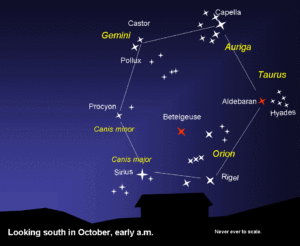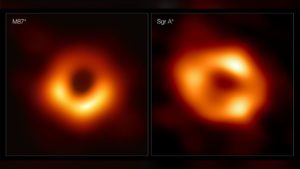
Those 50-plus people who attended Stratford Museum’s Friday evening January 20 show entitled ‘An Introduction into Astronomy’ were wowed by two great presentations.
Dr. Michael Burns provided a whirlwind tour of the history of Astronomy from the Babylonians to the Event Horizon Telescope project that recently photographed the Black Hole at the center of the Milky Way galaxy.
Paul Bartlett talked about the Winter Hexagon, visible in our winter skies throughout January, February, and March.
Both presenters are members of the Stratford Astronomy Group (SAG). They along with other SAG members attended along with telescopes. But the grey skies prevented night sky viewing. Telescopes along with eyepieces were set up inside the museum for display.
The Winter Hexagon is a collection of some of the brightest stars in the Northern Hemisphere’s winter sky (the Southern Hemisphere’s summer sky). Not a constellation on its own, but an asterism. The Winter Hexagon is a group of stars that form a noticeable pattern in the night sky.
It covers a large part of the winter sky. It’s made of the brightest stars from six different constellations: Rigel in Orion the Hunter, Aldebaran in Taurus the Bull, Capella in Auriga the Charioteer, Pollux in Gemini the Twins, Procyon in Canis Minor the Lesser Dog and Sirius in Canis Major the Greater Dog. Also, an additional 1st-magnitude star, Betelgeuse in Orion the Hunter, lies toward the center of the Hexagon. And as Paul explains, he became familiar with the winter sky by walking the family dog at night along an abandoned railway track in Tavistock, Ontario. The winter evenings and nights of January and February are best for viewing this asterism.
Paul provided us with a mnemonic that can be used to remember the six constellation stars that make up the Winter Hexagon, starting with Cappella and ending with Pollex: Captain, All the Riggings Seems Perfectly Polished (Cappella, Aldebaran, Rigel, Sirius, Procyon, Pollux). For another cool overview of the Winter Hexagon, watch this video clip.
Dr. Michael Burns, a retired astrophysicist, and SAG member delivered a “stellar” animated presentation of the universe, from its beginning to now.
With the help of a well-crafted visual presentation, Dr. Burns explained the problems of time and distance that earlier civilizations such as the Greeks and Babylonians wanted to resolve. How big is the Universe? What are the objects visible in the night sky? Why are some objects fixed in place following a similar pattern night after night while other objects appear to wander?
In their quest to explain what is seen in the night sky, the Babylonians developed mathematical systems which remain with us today. They used the sexagesimal system (based on the number 60), and they handed down to us the degree as a unit for measuring angles and 360 (the number of degrees in a circle or full rotation). We have 60 seconds in a minute. And 60 minutes in an hour.
In his brief history of astronomy, Dr. Burns noted that our understanding of the size of the Universe changes as our abilities to understand the data we observe becomes clearer.
Issac Newton deduced laws of motion that applied to everything we see and do. For Newton, gravity works with every object exerting a force on another object. Albert Einstein’s theory of relativity extended and refined Newton’s view. Instead of exerting an attractive force, Einstein, in his theory of general relativity, theorized that each object curves the fabric of space and time around them, forming a sort of well that other objects — and even beams of light — fall into. So Light travels in a straight line but spacetime bends with the mass of objects. When data obtained from a solar eclipse in 1919 showed that light from stars was bent by the sun’s mass, almost overnight Einstein became the world’s most famous scientist.
Then, Edwin Hubble, through careful observations of the heavens using the Mount Wilson telescope in California, from 1919 to 1929, determined that the Universe was bigger than the Milky Way galaxy. He deduced that there were many galaxies beyond the Milky Way and that the Universe is expanding at a constant rate. Again, the data proved Hubble to be correct in his predictions.
So the Universe is expanding? Yes, but the scientific community in the 1990s thought that the gravitational attraction of all the matter in the Universe would slow down this expansion that began 13 billion years ago with the primordial Big Bang. Instead, the data showed a different picture, a Universe whose expansion was accelerating. How is this possible? Dark energy and dark matter are two reasons.
Normal matter consists of the atoms that make up stars, planets, human beings, and every other visible object in the Universe. But this normal matter almost certainly accounts for the smallest proportion of the Universe, less than 5%.
The more astronomers observe the Universe, the more matter is needed to explain the data. This matter could not be made of normal atoms or there would be more stars and galaxies to be seen. Instead, they coined the term ‘dark matter’ for this peculiar substance precisely because it escapes our detection.
At present, even though many experiments are underway to detect dark matter particles, none have been successful. Nevertheless, astronomers still believe that approximately 25% of the Universe may consist of dark matter.
Dark energy is the latest addition to the contents of the Universe. Originally, Albert Einstein introduced the idea of ‘cosmic energy’ in his theory of general relativity to help explain why the Universe was not expanding or contracting in size. He and most of the scientific community at the time believed that the Universe was static. So, Einstein added a cosmological constant to his general relativity equation. All of this, before Hubble’s data, demonstrated that the Universe is expanding. The expanding Universe did not need a ‘cosmological constant’ as Einstein had called his energy. It is now thought that dark energy comprises 70% of the Universe.

Dr. Burns said that in 2019, astronomers using the Event Horizon Telescope (EHT) — an international collaboration that networked eight ground-based radio telescopes into a single Earth-size dish — captured an image of the Milky Way’s central black hole for the first time.
Remember, keep looking up.
Go to the TOP.


This was a great event! I really enjoyed it and I love looking up into the sky and seeing the Winter Hexagon — now that I know how to identify it. I keep telling everyone I know to look up and see the Winter Hexagon, too. I’d love to see more talks like this about the skies and stars and planets above us. Is there a Summer Hexagon, too??
Hi Tamara,
In the summer months, the night sky has the Summer Triangle asterism for our viewing.
Go to YouTube and search for Star Gazers “Sizing Up the Stars in the Summer Triangle”
Keep in touch with our website’s Calendar Events. The SAG club will host a star viewing party one night in May at the Stratford Museum. We will provide our telescopes to look at the night sky.
Thanks for your interest,
Tom